 W
WThe national symbols of Catalonia are flags, icons or cultural expressions that are emblematic, representative or otherwise characteristic of Catalonia or Catalan culture.
 W
WFutbol Club Barcelona, commonly referred to as Barcelona and colloquially known as Barça, is a Spanish professional football club based in Barcelona, that competes in La Liga, the top flight of Spanish football.
 W
WA barretina is a traditional hat that was frequently worn by men in parts of the Christian cultures of the Mediterranean Sea such as Catalonia, the Valencian Community, the Balearic Islands, Provence, Corsica, Sicily, Malta, Sardinia, part of Naples, part of the Balkans and parts of Portugal.
 W
WThe bat is a heraldic symbol sometimes used as a charge, but most prominently used as a crest on or around the crown in municipal arms of the former Crown of Aragon—specifically in Valencia, Catalonia and the Balearic Islands.
 W
WBotifarra is a type of sausage and one of the most important dishes of the Catalan cuisine.
 W
WThe Drummer of El Bruc is the name given to a popular Catalan legend derived from what happened during the Battle of El Bruc in the Peninsular War. According to the legend, the French defeat was due to a young boy who played the drums during the battle, the sound of which, echoing in the surrounding mountains, convinced the French troops that the number of their enemies was actually much larger than it really was. The name of the drummer is said to have been Isidre Lluçà i Casanoves (1791–1809), a peasant born in the nearby Santpedor.
 W
WThe Canigó is a mountain located in the Pyrenees of southern France.
 W
WThe Catalan Company or the Great Catalan Company was a company of mercenaries led by Roger de Flor in the early 14th century and hired by the Byzantine Emperor Andronikos II Palaiologos to combat the increasing power of the Anatolian beyliks. It was formed by almogavar veterans of the War of the Sicilian Vespers, who had remained unemployed after the signing in 1302 of the Peace of Caltabellotta between the Crown of Aragon and the French dynasty of the Angevins.
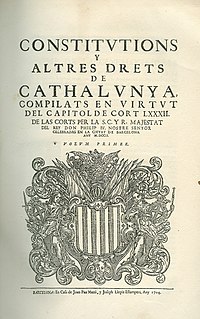 W
WThe Catalan constitutions were the laws of the Principality of Catalonia promulgated by the Count of Barcelona and approved by the Catalan Courts. The Corts in Catalan have the same origin as courts in English but instead meaning the legislature. The first constitutions were promulgated by the Corts of 1283. The last ones were promulgated by the Corts of 1705. They had pre-eminence over the other legal rules and could only be revoked by the Catalan Courts themselves. The compilations of the constitutions and other rights of Catalonia followed the Roman tradition of the Codex.
 W
WThe Catalan is a breed of large domestic donkey from the historic region of Catalonia, now in north-eastern Spain and south-western France. Approximately 80% of the breed population is in the modern autonomous community of Catalonia, and approximately 20% is in the historic Roussillon region of France.
 W
WThe Coat of arms of Catalonia is based on four red pallets on gold background which have been used since the Middle Ages as the arms of the Crown of Aragon.
 W
WThe Consell de Cent was a governmental institution of Barcelona. It was established in the 13th century and lasted until the 18th century.
 W
WCorrefocs ; literally in English "fire-runs") are among the most striking features present in Valencian and Catalan festivals. In the correfoc, a group of individuals will dress as devils and light up fireworks – fixed on devil's pitchforks or strung above the route. Dancing to the sound of a rhythmic drum group, they set off their fireworks among crowds of spectators. The spectators that participate dress to protect themselves against small burns and attempt to get as close as possible to the devils, running with the fire. Other spectators will watch from "safe" distances, rapidly retreating as necessary.
 W
WThe Estelada is an unofficial flag typically flown by Catalan independence supporters to express their support for either an independent Catalonia or independent Països Catalans. The use of this flag as a protest symbol within Catalan nationalism has become more notable since the 1970s Spanish transition to democracy. The design of the Estelada comprises the red-and-yellow bars of the Senyera, with the addition of a five-pointed star in a triangle at the hoist. It was not adopted as the national flag of the proclaimed Catalan Republic (2017), the legitimacy of which was disputed. Instead the senyera was the flag that was used.
 W
WThe European dragon is a legendary creature in folklore and mythology among the overlapping cultures of Europe.
 W
WPatufet is the main character of one of the most famous folktales of Catalan tradition.
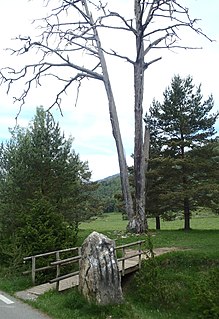 W
WPi de les tres branques is a dead pine tree located in the countryside near the town of Berga in north-central Catalonia, Spain. It has long been regarded by some Catalan nationalists as representing the unity of the three "Catalan Countries" and is the site of regular political-cultural gatherings.
 W
WPoblet Abbey, otherwise the Royal Abbey of Santa Maria de Poblet, is a Cistercian monastery, founded in 1151, located at the foot of the Prades Mountains, in the comarca of Conca de Barberà, in Catalonia (Spain). It was founded by Cistercian monks from France on lands conquered from the Moors. The main architect was Arnau Bargués.
 W
WThe Renaixença, or Catalan Renaissance, was an early 19th-century romantic revivalist movement in Catalan language and culture, akin to the Galician Rexurdimento or the Occitan Félibrige movements. The movement dates to the 1830s and 1840s, but lasted into the 1880s, when it branched out into other cultural movements. Even though it primarily followed a romantic impulse, it incorporated stylistic and philosophical elements of other 19th century movements such as Naturalism or Symbolism. The name does not indicate a particular style, but rather the cultural circumstances in which it bloomed.
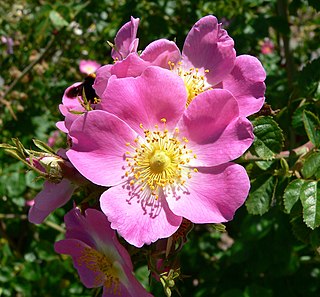 W
WA rose is a woody perennial flowering plant of the genus Rosa, in the family Rosaceae, or the flower it bears. There are over three hundred species and tens of thousands of cultivars. They form a group of plants that can be erect shrubs, climbing, or trailing, with stems that are often armed with sharp prickles. Flowers vary in size and shape and are usually large and showy, in colours ranging from white through yellows and reds. Most species are native to Asia, with smaller numbers native to Europe, North America, and northwestern Africa. Species, cultivars and hybrids are all widely grown for their beauty and often are fragrant. Roses have acquired cultural significance in many societies. Rose plants range in size from compact, miniature roses, to climbers that can reach seven meters in height. Different species hybridize easily, and this has been used in the development of the wide range of garden roses.
 W
WIn heraldry, Saint George's Cross, also called the Cross of Saint George, is a red cross on a white background, which from the Late Middle Ages became associated with Saint George, the military saint, often depicted as a crusader.
 W
WSalses-le-Château or just Salses is a commune in the Pyrénées-Orientales department in southern France. It is located north of the city of Perpignan.
 W
WEls Segadors is the official national anthem of Catalonia, nationality and autonomous community of Spain.
 W
WSeny is a form of ancestral Catalan wisdom or sensibleness. It involves well-pondered perception of situations, level-headedness, awareness, integrity, and right action. More specifically, a National Geographic anthropologist defined seny as "a kind of refined good sense and self-realization."
 W
WThe Senyera is a vexillological symbol based on the coat of arms of the Crown of Aragon, which consists of four red stripes on a yellow field. This coat of arms, often called bars of Aragon, or simply "the four bars", historically represented the King of the Crown of Aragon.
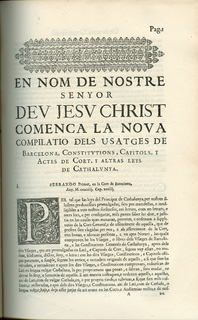 W
WThe Usages of Barcelona were the customs that form the basis for the Catalan Constitutions. They are the fundamental laws and basic rights of Catalonia, dating back to their codification in the twelfth century.
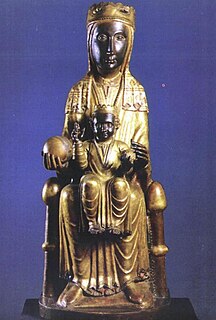 W
WOur Lady of Montserrat or the Virgin of Montserrat is a Marian title associated with a statue of the Madonna and Child venerated at the Santa Maria de Montserrat monastery on the Montserrat Mountain in Catalonia, Spain. She is the Patron Saint of Catalonia, an honour she shares with Saint George. The famed image once bore the inscription ''Nigra Sum Sed Formosa".